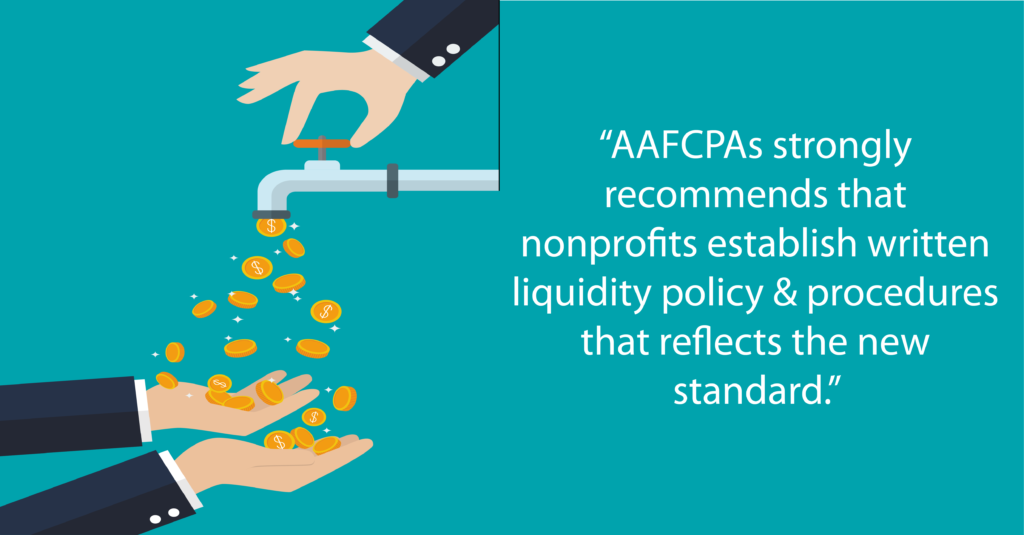Liquidity Considerations for Nonprofits Implementing the New Financial Statement Presentation Framework
AAFCPAs advises nonprofits in assessing the impact of the new Accounting Standards Update (ASU) No. 2016-14, Not-for-Profit Entities (Topic 958): Presentation of Financial Statements of Not-for-Profit Entities, and we provide guidance throughout the transition process. ASU 2016-14 affects nonprofit organizations in all industries (i.e. healthcare, affordable housing, social services, foundations and education) and is effective for fiscal years beginning after December 15, 2017 (CY 2018 or FY 2019).
Liquidity and Availability of Resources
 The new financial statement presentation framework includes new liquidity and availability of resources disclosure requirements. ASU 2016-14 requires nonprofits to provide the following:
The new financial statement presentation framework includes new liquidity and availability of resources disclosure requirements. ASU 2016-14 requires nonprofits to provide the following:
- Qualitative information in the notes to the financial statements on how the nonprofit manages its liquid resources to meet cash needs for general expenditures within one year of the statement of financial position date, and
- Quantitative information either on the face of the statement of financial position or in the notes about the availability of a nonprofit’s financial assets to meet cash needs for general expenditures within one year of the statement of financial position date.
- Additional qualitative information about the availability of the financial assets may be provided, as necessary.
Implementation Considerations
During implementation, AAFCPAs advises nonprofits to first identify all financial assets and any limitations on the availability of the identified financial assets. Financial assets is defined under U.S. GAAP as cash, contracts to receive cash (i.e. receivables, debt securities), and evidence of equity ownership in another entity (i.e. equity securities). The availability of financial assets may be affected by: (1) its nature, (2) external limits imposed by donors, grantors, laws and contracts with others, and (3) internal limits imposed by governing board decisions.
AAFCPAs strongly recommends that nonprofits establish written liquidity policy and procedures that reflects the new standard. Items that should be included in this policy are as follows:
- Procedures to identify financial assets and assess the availability of each financial asset to meet cash needs for general expenditures within one year of the statement of financial position date. Items usually not available for general expenditures include certain board-designated funds, donor restricted funds for particular purposes or periods beyond one year, donor-advised funds, cash restricted for capital projects, and investments held in annuity trusts.
- Process to identify liquidity risks and strategies and actions taken to manage liquidity needs; for example, access to lines of credit or other financing sources, or to establish liquidity reserves or short-term investments. A liquidity reserve is not required under the new standard but if a nonprofit decides to set up a liquidity reserve as part of its liquidity management plan, specific disclosure in the financial statements is required. In the liquidity policy, the nonprofit will need to define the purpose and intention of the designation for the liquidity reserve, if any, and whether or not it will be used to support the general expenditures within one year, or unanticipated future liquidity needs.
Nonprofits should also determine the best way to disclose the liquidity information in the financial statements. Nonprofits may choose to present the required disclosures in either a table format, and/or text format in the notes to the financial statements. In addition, if a table format is preferred, nonprofits have two options to display the balance of financial assets available within one year from the statement of financial positon date for general expenditures:
- Display the gross amount of financial assets, then adjustments to arrive at the balance available for general expenditures
- Display only the net amounts available for general expenditures
AAFCPAs is available to advise clients on reviewing and updating accounting policies and procedures to reflect any changes, including solutions for processing information and producing financial reporting in line with the new reporting standard. Learn more. >>
If you have any additional questions about how the new ASU will impact you, please contact Matt Hutt, CPA, CGMA, at 774.512.4043, mhutt@nullaafcpa.com; Hui-Ting Grady, CPA, at 774.512.4106, hgrady@nullaafcpa.com; or your AAFCPAs Partner.
Related Insights
- eBook: AAFCPAs’ Guidance on New Nonprofit Financial Statement Framework
- Net Asset Classification Considerations for Nonprofits Implementing the Financial Statement Presentation Standards
- Underwater Endowment Considerations for Nonprofits Implementing the New Financial Statement Presentation Framework
- Expense Reporting Considerations for Nonprofits Implementing the New Financial Statement Presentation Framework


